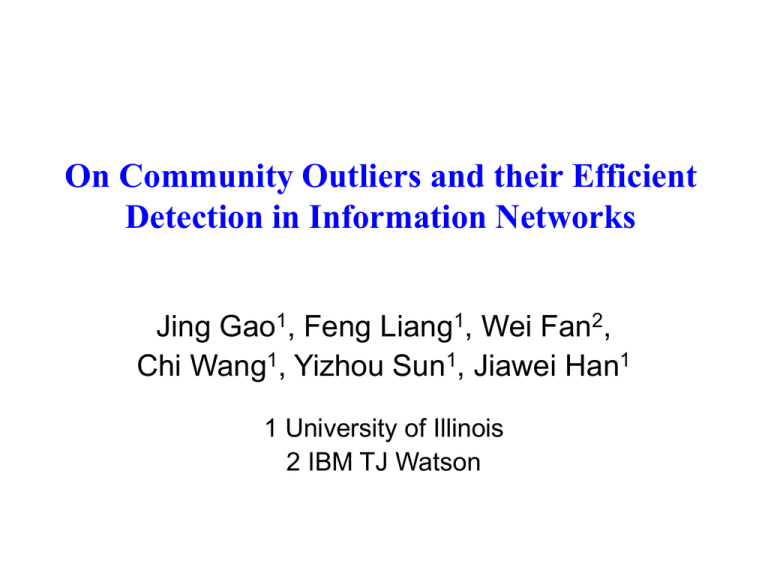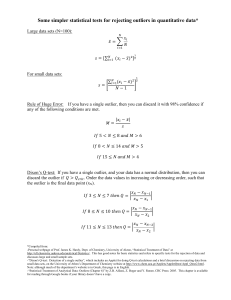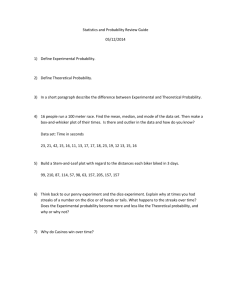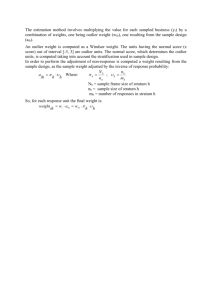On Community Outliers and their Efficient Detection in Information Networks Jing Gao
advertisement

On Community Outliers and their Efficient Detection in Information Networks Jing Gao1, Feng Liang1, Wei Fan2, Chi Wang1, Yizhou Sun1, Jiawei Han1 1 University of Illinois 2 IBM TJ Watson Information Networks • Node represents an entity – Each node has feature values – e.g., users in social networks, webpages on internet • Link represents relationship between entities – e.g., two users are linked if they are friends; two webpages are linked through hyper-links • Information networks are ubiquitous 2 Outlier (Anomaly, Novelty) Detection • Goal – Identify points that deviate significantly from the majority of the data Y N1 o1 O3 o2 N2 from A. Banerjee, V.Chandola, V. Kumar, J.Srivastava. Anomaly Detection: A Tutorial. SDM’08 X Outliers 3 Community Outliers • Definition – Two information sources: links, node features – There exist communities based on links and node features – Objects that have feature values deviating from those of other members in the same community are defined as community outliers high-income 70K V1 160K 30K V2 V8 low-income V7 10K 10K 140K V3 V9 100K V4 community outlier V6 40K 110K V5 V10 30K 4 Contextual (Conditional) Outliers • Global vs. Contextual – Global: identify outliers among all the data – Contextual: identify outliers within a subset of data defined by contextual features 5 Examples • Contexts – a subset of features, temporal, spatial, or communities in networks (in this paper) temporal contexts spatial contexts 6 Outliers in Information Networks 1) Global outlier: only consider node features Global Outlier V7 V8 V9 V10 V6 V1 V4 V5 V3 V2 10 30 40 70 100 110 Salary (in $1000) 140 160 structural outlier 2) Structural outlier: only consider links 70K V1 3) Local outlier: only consider the feature values of direct neighbors 160K 30K V2 V8 V7 10K 10K 140K V3 V9 100K 40K V6 V4 110K V10 30K V5 local outlier 7 Unified Model is Needed • Links and node features – More meaningful to identify communities based on links and node features together • Community discovery and outlier detection – Outliers affect the discovery of communities consider links only 70K V1 160K 30K V2 V8 V7 10K 10K 140K V3 V9 100K 40K V6 V4 110K V10 30K V5 8 A Unified Probabilistic Model (1) outlier community label Z node features X link structure W K: number of communities high-income: mean: 116k std: 35k low-income: mean: 20k std: 12k model parameters 9 A Unified Probabilistic Model (2) • Probability – Maximize P(X) P(X|Z)P(Z) – P(X|Z) depends on the community label and model parameters • eg., salaries in the high or low-income communities follow Gaussian distributions defined by mean and std – P(Z) is higher if neighboring nodes from normal communities share the same community label • eg., two linked persons are more likely to be in the same community • outliers are isolated—does not depend on the labels of neighbors 10 Modeling Continuous or Text Data • Continuous – Gaussian distribution – Model parameters: mean, standard deviation • Text – Multinomial distribution – Model parameters: probability of a word appearing in a community 11 Community Outlier Detection Algorithm Initialize Z : model parameters Z: community labels Fix Z, find that maximizes P(X|Z) Parameter estimation Fix , find Z that maximizes P(Z|X) Inference 12 Inference (1) • Calculate Z – Model parameters are known – Iteratively update the community labels of nodes – Select the label that maximizes P(Z|X,ZN) highincome mean: high-income: 110k 100k lowincome low-income: 30k highincome high-income? 80% low-income? 10% outlier? 10% 13 Inference (2) • Calculate P(Z|X,ZN) – Consider both the node features and community labels of neighbors if Z indicates a normal community – If the probability of a node belonging to any community is low enough, label it as an outlier highincome mean: high-income: 100k low-income: 30k 100k high-income: lowincome highincome P(salary=100k|high-income) P(high-income|neighbors) low-income: P(salary=100k|low-income) P(low-income|neighbors) outlier: constant 14 Parameter Estimation • Calculate model parameters – maximum likelihood estimation • Continuous – mean: sample mean of the community – standard deviation: square root of the sample variance of the community • Text – probability of a word appearing in the community: empirical probability 15 Simulated Experiments • Data – Generate continuous data based on Gaussian distributions and generate labels according to the model – r: percentage of outliers, K: number of communities • Baseline models – GLODA: global outlier detection (based on node features only) – DNODA: local outlier detection (check the feature values of direct neighbors) – CNA: partition data into communities based on links and then conduct outlier detection in each community 16 Precision 0.8 0.7 0.6 0.5 GLODA DNODA 0.4 CNA 0.3 CODA 0.2 0.1 0 r=1 % K=5 r=5 % K=5 r=1 % K=8 r=5 % K=8 17 Experiments on DBLP • Data – DBLP: computer science bibliography – Areas: data mining, artificial intelligence, database, information analysis • Case studies – Conferences: • Links: percentage of common authors among two conferences • Node features: publication titles in the conference – Authors: • Links: co-authorship relationship • Node features: titles of publications by an author 18 Case Studies on Conferences Community outliers: CVPR CIKM 19 Conclusions • Community Outliers – Nodes that have different behaviors compared with the others in the community • Community Outlier Detection – A unified probabilistic model – Conduct community discovery and outlier detection simultaneously – Consider both links and node features 20 Thanks! • Any questions? 21
![[#GEOD-114] Triaxus univariate spatial outlier detection](http://s3.studylib.net/store/data/007657280_2-99dcc0097f6cacf303cbcdee7f6efdd2-300x300.png)






